BIM Extraction Software Market
BIM Extraction Software Market Analysis, By Component, By Deployment Mode, By Functionality, By Application, By End User, By Industry Vertical, and Region - Market Insights 2025 to 2035
The Software segment is projected to grow at a CAGR of 11.9%, whereas another segment Services is likely to grow at 10.9%. In terms of countries US is projected to grow at 10%, followed by China at 12.5% and Germany to grow at 8.3%.
BIM Extraction Software Market Outlook (2025 to 2035)
The global BIM extraction software market is projected to grow from USD 10,776 million in 2024 to USD 35,960 million by 2035. During the forecast period 2025 to 2035, the industry is projected to expand at a CAGR of 11.6%. BIM extraction software plays a key role in converting complex building information into usable formats for analysis, planning, and construction.
It streamlines workflows and supports the extraction of 3D models, quantities, and attributes from BIM files, thereby assisting in informed decision-making, accurate costing, and enhanced project efficiency. Demand for this software is increasing with the advancement of digital processes and the development of smart infrastructure in the architecture, engineering, and construction sectors.
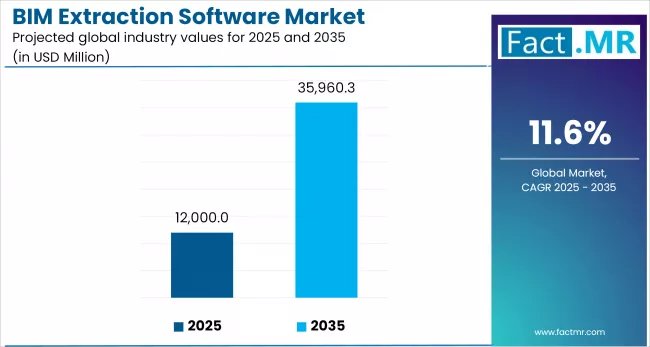
What drives growth in the BIM extraction software market amid rising demand for digital construction solutions?
A key factor driving the market for BIM extraction software is the increasing demand across the construction landscape for improved precision and efficiency in project management. Traditional construction methods often incur cost escalations, delayed schedules, and design conflicts.
The BIM extraction software addresses these issues by enabling real-time access to model data, supporting more informed decision-making at each stage of the project. Moreover, global trends in infrastructure investment, especially in urban transit, green buildings, and smart cities, demand highly capable planning and management tools.
Several governments have introduced mandates for the widespread use of BIM in public infrastructure, such as a Level 2 BIM requirement in the UK and various forms of it in Asia and Europe, thereby further strengthening the adoption of BIM in both private and public sectors. Another emerging factor is the rapid integration of AI and cloud computing into construction workflows, offering scalable and collaborative platforms that will enhance the potential of BIM tools.
With environmental regulations tightening, stakeholders are increasingly turning to BIM to conduct sustainability assessments and lifecycle cost evaluations. This evolving alignment of regulatory policies, emerging technologies, and market demands is fueling the adoption of BIM extraction solutions worldwide.
What are the regional trends of the BIM Extraction Software Market?
From a geographical perspective, the BIM extraction software market is steadily gaining momentum in several key regions.
North America holds a significant share, supported by the adoption of BIM in the U.S. and Canada. The presence of established software vendors, supportive government policies such as federal BIM mandates for public infrastructure, and a high level of digitization of construction practices are some factors contributing to this growth. The U.S. General Services Administration (GSA), along with other agencies, has been an early adopter of BIM and promoted industry-wide compliance.
Large-scale urban development projects and smart city initiatives are driving growth in East Asian countries, including China, South Korea, and Japan. BIM integration with AI and IoT in construction projects are gaining momentum in the region, while governmental initiatives to promote digital construction standards and improve construction productivity further consolidate East Asia's presence in the global market.
Western Europe also holds a significant market presence. The United Kingdom, Germany, and France are at the forefront of policy-driven BIM technology adoption. The UK's mandate for Level 2 BIM on public sector projects has influenced practices across the continent, with other nations gradually adopting similar standards. Western Europe leads in promoting BIM for sustainability compliance and whole-life asset management.
Why do small construction firms face challenges adopting BIM extraction software despite its clear benefits?
Despite a positive growth forecast, the progression toward full acceptance of BIM extraction software faces several challenges. Key restraints arise from the high initial cost of implementation, particularly for small and medium-sized enterprises.
Many small firms lack the financial resources for such investments or do not possess the necessary technical infrastructure to install advanced BIM platforms and extraction tools. Significant interoperability issues between different software providers in the BIM arena essentially create data silos, thus hindering collaboration.
These issues are further intensified by the lack of widely accepted standards for BIM data formatting. Another considerable challenge is the high learning curve associated with installation and an extensive training regime for acquiring skills in BIM tools; this barrier is particularly prevalent in developing areas where digital literacy levels in the construction sector are low.
Concerns about data security are also increasing, particularly with the use of cloud-based platforms that may not yet offer fully proven protection against unauthorized access or misuse. As a result, stakeholders may be hesitant to share sensitive project data via cloud systems.
Resistance to organizational change and the established tradition of workflow can significantly impede adoption, in spite of having supporting regulatory frameworks in the regions. Collectively, these factors continue to slow the pace of digital transformation across the construction industry.
Country-wise Outlook
U.S. Emerges as a Mature and Innovation-Driven Hub for BIM Extraction Software
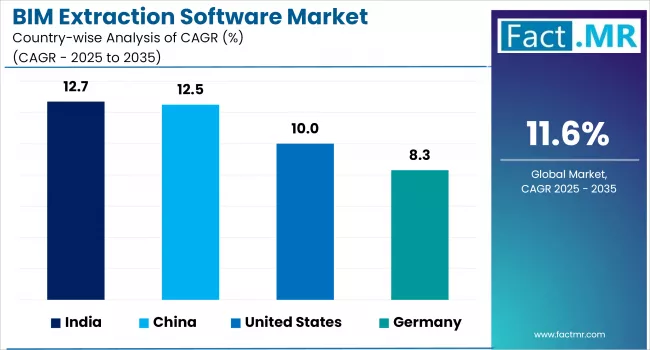
The BIM extraction software market in the United States is experiencing growth, driven by the broader adoption of digital construction technologies and an increasing demand for integrated project lifecycle management. Public and private infrastructure projects in the United States benefit from a well-established construction sector and federal mandates supporting digital transformation.
Leading architectural engineering firms utilize BIM extraction tools and software to optimize workflows, enhance accuracy, and facilitate improved coordination among project stakeholders. The expansion of cloud-based platforms, combined with machine learning and AI, has significantly enhanced the level of data processing and predictive analytics applicable in the BIM arena.
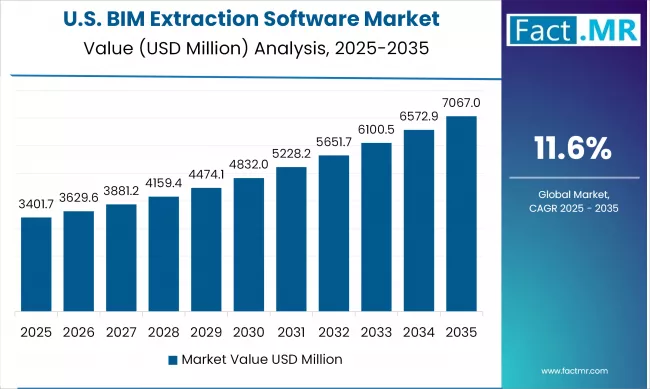
With the increasing emphasis on sustainable and smart infrastructure, BIM software is increasingly utilized for energy modeling, environmental assessments, and compliance with green building standards. The United States is expected to remain a mature and innovation-driven market for BIM extraction technologies, owing to its strong digital environment and government support.
Germany Accelerates Adoption Through Mandates and Sustainable Construction Focus
Germany's BIM extraction software market is continuing to gain momentum through a combination of regulatory requirements and the construction industry's shift towards sustainability and digitalization. With the German government’s mandate for the use of BIM in public sector construction projects, there has been an increased awareness and integration of digital tools into the entire life cycle of buildings.
Stakeholders in architecture, engineering, and infrastructure are adopting BIM extraction tools to enhance design accuracy, improve resource efficiency, and facilitate collaborative planning. The alignment between Germany’s long-standing commitment to engineering excellence and its focus on environmentally responsible practices complements the capabilities of BIM software, particularly in initiatives related to energy-efficient and carbon-neutral construction.
Cloud-based solutions and open data formats are expected to have a growing influence on project execution, allowing timely coordination among geographically dispersed teams. This progression from conceptual planning to digital implementation, supported by both industry consensus and policy direction, positions Germany as one of the most actively targeted markets in Europe for the adoption of BIM software.
China Advances with Tech-Integrated Urban Development and Smart Construction
The BIM extraction software market is continuing to expand rapidly, driven by sustained momentum in urbanization and digital infrastructure. Government-led strategic initiatives targeted toward smart cities and digital construction practices have created an environment favorable for the adoption of BIM software.
The growing complexity of large-scale urban development and infrastructure projects has led to an increased need for intelligent and integrated planning tools. BIM extraction software plays a crucial role in such projects, facilitating accurate data modeling, design coordination, and lifecycle management.
Through its open approach to technology, China has encouraged the integration of BIM platforms with emerging technologies, including IoT, AI, and blockchain. Local construction companies have embraced these tools and further customized them to fit regional codes and working procedures. This digitally driven orientation in development and construction positions the country as one of the most dynamic and fast-developing markets for BIM technologies worldwide.
Category-Wise Market Outlook
Integrated Modules Gain Traction as Firms Prioritize Workflow Efficiency and Interoperability
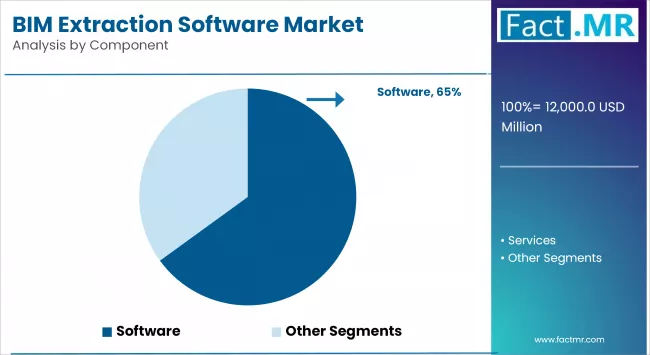
Integrated BIM modules are witnessing rapid growth within the CAD/BIM platforms. Their broader integration with platforms such as AutoCAD and Revit enhances user efficiency and project execution. These modules build interoperability and support end-to-end workflows.
As a result, firms increasingly prefer integrated modules over standalone tools, particularly as clients prioritize comprehensive solutions that connect design and extraction functions. Demand for integrated modules has increased in an environment where multidisciplinary teams strive to enhance collaboration and reduce project cycle times.
Cloud Deployment Surges Ahead Amid Demand for Flexibility and Real-Time Collaboration
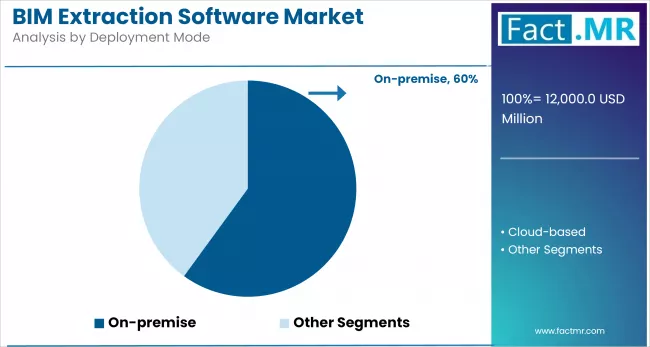
Cloud deployment, due to its scalability, availability, and operability without any significant IT infrastructure setup, is overtaking on-premise installations. With remote and hybrid working models gaining more acceptance in the construction and design industries, cloud deployment is becoming increasingly essential.
It enables real-time collaboration in dispersed geographically teams, thereby ensuring the smooth synchronizing of data across devices and platforms. Also noteworthy is the frequency of updates, which positions cloud-based implementations as a cost-efficient and flexible solution for small and medium-sized firms.
Scan-to-BIM Adoption Rises with Growing Need for Accurate Retrofitting and Smart Infrastructure
Point cloud processing and scan-to-BIM functionality have been experiencing steady traction in adoption. This growth is driven by the increasing need for retrofitting existing buildings and infrastructure, while allowing for accurate 3D scanning and digitization.
The technology transforms laser scans into accurate BIM models, which are invaluable for renovation, restoration, and facility management. As smart infrastructure arrangements expand and building lifecycles become increasingly data-intensive, the functionality forms a central element of current digital construction practices.
Facility Management Gains Ground as BIM Supports Long-Term Asset Performance
Facility management is emerging gradually. The use of BIM for operational and maintenance planning after construction is increasing, alongside the development of smart buildings and sustainable infrastructure mandates.
BIM facilitates the creation of a digital twin for physical assets, enabling efficient maintenance, energy management, and optimal space utilization. As property owners and operators focus on long-term asset performance, BIM for facility management continues to gain momentum.
Competitive Analysis
Increased emphasis on digitization in the construction industry and the use of point cloud technologies for efficient data modeling, the BIM extraction software market is undergoing notable transformation. Companies are working to refine the automated extraction of usable data from laser scans and 3D models to improve productivity, accuracy in design planning and construction.
Leading firms such as Autodesk, Bentley Systems, and Trimble are enhancing the capabilities of their software with AI, cloud-based collaboration, and digital twin features for their market position.
New entrants, such as ClearEdge3D, PointCab GmbH, and Geo-Plus, are carving out niches for themselves by offering highly specialized point cloud-to-BIM solutions. Additionally, the industry is poised for growth in strategic partnerships, software interoperability initiatives, and increased adoption of open BIM standards.
This evolving environment, along with growing requirements for accuracy, workflow efficiency, and collaborative project execution, is supporting innovation and integration of intelligent modeling software with hardware systems.
Key Market Players of the BIM extraction software industry are Assemble Systems, Autodesk Inc., AVEVA Group Plc., Bentley Systems Inc., ClearEdge3D, FARO Technologies, Geo-Plus VisionLidar, GEXCEL, Innovaya, Leica, Microsoft Corporation, Nemetschek Group, PointCab GmbH, Safe Software, SierraSoft, Synchro Software Ltd., Technodigit- 3D Reshaper, Tekla, Trimble RealWorks, Vectorworks Inc.
Recent Development:
- In June 2023, FARO Technologies released version 2023.0 of its As-Built Modeler software, introducing significant enhancements to streamline scan-to-BIM workflows. Key updates include support for FARO Flash Scans, improved compatibility with the e57 standard, enhanced software security through updated third-party libraries, and a revamped license activation process. These improvements aim to provide AEC professionals with more efficient and secure tools for extracting precise 3D features from point cloud data.
- In May 2023, Autodesk unveiled Autodesk Forma, a cloud-based platform designed to enhance early-stage planning and design processes in the architecture, engineering, and construction (AEC) industry. Forma integrates automation and AI-powered insights to streamline design exploration, offload repetitive tasks, and evaluate environmental factors like sunlight and wind, thereby facilitating more informed decision-making. This launch represents Autodesk's commitment to advancing BIM capabilities through cloud offerings and AI integrations.
Fact.MR has provided detailed information about the price points of key manufacturers of the BIM Extraction Software Market positioned across regions, sales growth, production capacity, and speculative technological expansion, in the recently published report.
Segmentation of BIM Extraction Software Market Research
-
By Component :
- Software
- Standalone BIM extraction tools
- Integrated BIM modules in CAD/BIM platforms
- Services
- Implementation & integration
- Support & maintenance
- Consulting
- Software
-
By Deployment Mode :
- On-premise
- Cloud-based
-
By Functionality :
- 3D Model Extraction
- Data & Attribute Extraction
- Point Cloud Processing & Scan-to-BIM
- Clash Detection & Resolution
- Documentation Generation
- Quantity Takeoff & Cost Estimation
-
By Application :
- Architectural Design
- Structural Engineering
- MEP (Mechanical, Electrical, Plumbing) Modeling
- Construction Planning
- Facility Management
- Renovation & Restoration
-
By End User :
- Architects
- Engineers
- General Contractors
- Construction Managers
- Facility Managers
- Surveying & Scanning Professionals
-
By Industry Vertical :
- Residential Construction
- Commercial Buildings
- Industrial Facilities
- Healthcare Infrastructure
- Transportation Infrastructure
- Utilities & Energy
-
By Region :
- North America
- Latin America
- Western Europe
- Eastern Europe
- East Asia
- South Asia & Pacific
- Middle East & Africa
Table of Content
- Executive Summary
- Industry Introduction, including Taxonomy and Market Definition
- Trends and Success Factors, including Macro-economic Factors, Market Dynamics, and Recent Industry Developments
- Global Market Demand Analysis 2020 to 2024 and Forecast 2025 to 2035, including Historical Analysis and Future Projections
- Pricing Analysis
- Global Market Analysis 2020 to 2024 and Forecast 2025 to 2035
- Component
- Deployment Mode
- Functionality
- Application
- End User
- Industry Vertical
- Global Market Analysis 2020 to 2024 and Forecast 2025 to 2035, By Component
- Software
- Standalone BIM extraction tools
- Integrated BIM modules in CAD/BIM platforms
- Services
- Implementation & integration
- Support & maintenance
- Consulting
- Software
- Global Market Analysis 2020 to 2024 and Forecast 2025 to 2035, By Deployment Mode
- On-premise
- Cloud-based
- Global Market Analysis 2020 to 2024 and Forecast 2025 to 2035, By Functionality
- 3D Model Extraction
- Data & Attribute Extraction
- Point Cloud Processing & Scan-to-BIM
- Clash Detection & Resolution
- Documentation Generation
- Quantity Takeoff & Cost Estimation
- Global Market Analysis 2020 to 2024 and Forecast 2025 to 2035, By Application
- Architectural Design
- Structural Engineering
- MEP (Mechanical, Electrical, Plumbing) Modeling
- Construction Planning
- Facility Management
- Renovation & Restoration
- Global Market Analysis 2020 to 2024 and Forecast 2025 to 2035, By End User
- Architects
- Engineers
- General Contractors
- Construction Managers
- Facility Managers
- Surveying & Scanning Professionals
- Global Market Analysis 2020 to 2024 and Forecast 2025 to 2035, By Industry Vertical
- Residential Construction
- Commercial Buildings
- Industrial Facilities
- Healthcare Infrastructure
- Transportation Infrastructure
- Utilities & Energy
- Global Market Analysis 2020 to 2024 and Forecast 2025 to 2035, By Region
- North America
- Latin America
- Western Europe
- Eastern Europe
- East Asia
- South Asia Pacific
- Middle East & Africa
- North America Sales Analysis 2020 to 2024 and Forecast 2025 to 2035, by Key Segments and Countries
- Latin America Sales Analysis 2020 to 2024 and Forecast 2025 to 2035, by Key Segments and Countries
- Western Europe Sales Analysis 2020 to 2024 and Forecast 2025 to 2035, by Key Segments and Countries
- Eastern Europe Sales Analysis 2020 to 2024 and Forecast 2025 to 2035, by Key Segments and Countries
- East Asia Sales Analysis 2020 to 2024 and Forecast 2025 to 2035, by Key Segments and Countries
- South Asia Pacific Sales Analysis 2020 to 2024 and Forecast 2025 to 2035, by Key Segments and Countries
- Middle East & Africa Sales Analysis 2020 to 2024 and Forecast 2025 to 2035, by Key Segments and Countries
- Sales Forecast to 2035 by Component, Deployment Mode, Functionality, Application, End User, and Industry Vertical for 30 Countries
- Competitive Assessment, Company Share Analysis by Key Players, and Competition Dashboard
- Company Profile
- Assemble Systems
- Autodesk Inc.
- AVEVA Group Plc.
- Bentley Systems Inc.
- ClearEdge3D
- FARO Technologies
- Geo-Plus VisionLidar
- GEXCEL
- Innovaya
- Leica
- FAQs -
What was the Global BIM Extraction Software Market Size Reported by Fact.MR for 2024?
The global BIM extraction software market was valued at USD 10,776 million in 2024.
Who are the Major Players Operating in the BIM Extraction Software Market?
Prominent players in the market are Assemble Systems, Autodesk Inc., AVEVA Group Plc., Bentley Systems Inc., ClearEdge3D, FARO Technologies, Geo-Plus VisionLidar, among others.
What is the Estimated Valuation of the BIM Extraction Software Market in 2035?
The market is expected to reach a valuation of USD 35,960 million in 2035.
What Value CAGR did the BIM Extraction Software Market Exhibit Over the Last Five Years?
The historic growth rate of the BIM extraction software market was 10.2% from 2020 to 2024.